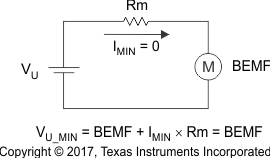ZHCSDA7G July 2014 – February 2018 DRV10983
PRODUCTION DATA.
- 1 特性
- 2 应用
- 3 说明
- 4 修订历史记录
- 5 说明 (续)
- 6 Pin Configuration and Functions
- 7 Specifications
-
8 Detailed Description
- 8.1 Overview
- 8.2 Functional Block Diagram
- 8.3 Feature Description
- 8.4
Device Functional Modes
- 8.4.1 Motor Parameters
- 8.4.2 Starting the Motor Under Different Initial Conditions
- 8.4.3 Motor Start Sequence
- 8.4.4 Start-Up Current Setting
- 8.4.5 Closed Loop
- 8.4.6 Current Limit
- 8.4.7 Lock Detect and Fault Handling
- 8.4.8 AVS Function
- 8.4.9 PWM Output
- 8.4.10 FG Customized Configuration
- 8.4.11
Diagnostics and Visibility
- 8.4.11.1 Motor Status Readback
- 8.4.11.2 Motor Speed Readback
- 8.4.11.3 Motor Electrical Period Readback
- 8.4.11.4 BEMF Constant Readback
- 8.4.11.5 Motor Estimated Position by IPD
- 8.4.11.6 Supply Voltage Readback
- 8.4.11.7 Speed Command Readback
- 8.4.11.8 Speed Command Buffer Readback
- 8.4.11.9 Fault Diagnostics
- 8.5 Register Maps
- 9 Application and Implementation
- 10Power Supply Recommendations
- 11Layout
- 12器件和文档支持
- 13机械、封装和可订购信息
8.4.8.1 Mechanical AVS Function
If the speed command suddenly drops such that the BEMF voltage generated by the motor is greater than the voltage that is applied to the motor, then the mechanical energy of the motor is returned to the power supply and the VCC voltage surges. The mechanical AVS function works to prevent this from happening. The DRV10983 buffers the speed command value and limits the resulting output voltage, UMIN, so that it is not less than the BEMF voltage of the motor. The BEMF voltage in the mechanical AVS function is determined using the programmed value for the Kt of the motor (Kt[6:0]) along with the speed. Figure 35 shows the criteria used by the mechanical AVS function.
 Figure 35. Mechanical AVS
Figure 35. Mechanical AVS
The mechanical AVS function can operate in one of two modes, which can be configured by the register bit AVSMMd:
AVSMMd = 0 – AVS mode is always active to prevent the applied voltage from being less than the BEMF voltage.
AVSMMd = 1 – AVS mode becomes active when VCC reaches 24 V. The motor acts as a generator and returns energy into the power supply until VCC reaches 24 V. This mode can be used to enable faster deceleration of the motor in applications where returning energy to the power supply is allowed.